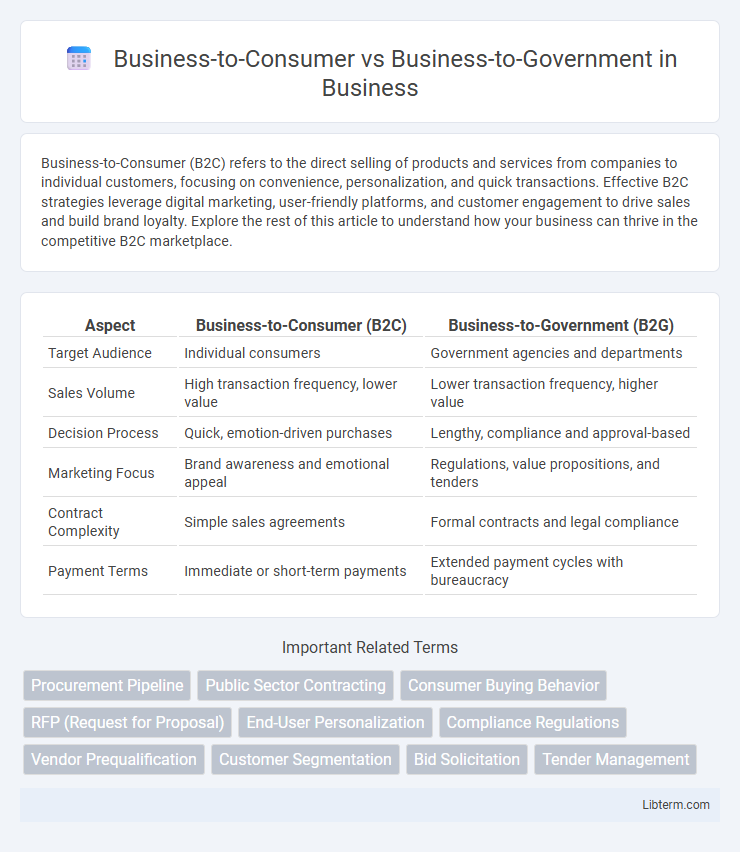Business-to-Consumer (B2C) refers to the direct selling of products and services from companies to individual customers, focusing on convenience, personalization, and quick transactions. Effective B2C strategies leverage digital marketing, user-friendly platforms, and customer engagement to drive sales and build brand loyalty. Explore the rest of this article to understand how your business can thrive in the competitive B2C marketplace.
Table of Comparison
| Aspect | Business-to-Consumer (B2C) | Business-to-Government (B2G) |
|---|---|---|
| Target Audience | Individual consumers | Government agencies and departments |
| Sales Volume | High transaction frequency, lower value | Lower transaction frequency, higher value |
| Decision Process | Quick, emotion-driven purchases | Lengthy, compliance and approval-based |
| Marketing Focus | Brand awareness and emotional appeal | Regulations, value propositions, and tenders |
| Contract Complexity | Simple sales agreements | Formal contracts and legal compliance |
| Payment Terms | Immediate or short-term payments | Extended payment cycles with bureaucracy |
Introduction to B2C and B2G Models
Business-to-Consumer (B2C) models target individual consumers, emphasizing user-friendly interfaces, personalized marketing, and quick transaction processes to enhance customer experience. Business-to-Government (B2G) models focus on supplying products or services to government agencies, often requiring compliance with specific regulations, formal bidding processes, and long-term contract management. Understanding the distinct purchasing behaviors and procurement cycles in both B2C and B2G markets is essential for optimizing sales strategies and operational efficiency.
Key Differences Between B2C and B2G
Business-to-Consumer (B2C) targets individual customers with personalized marketing and fast purchasing processes, emphasizing emotional appeal and convenience. Business-to-Government (B2G) involves transactions with government agencies, requiring compliance with strict regulations, longer sales cycles, and competitive bidding processes. B2C focuses on high-volume sales and brand loyalty, while B2G centers on contract-based relationships and adherence to public sector procurement standards.
Target Audience and Customer Segments
Business-to-Consumer (B2C) targets individual consumers who seek personal use products and services, emphasizing emotional appeal and convenience. Business-to-Government (B2G) focuses on government agencies and public sector organizations, requiring compliance with strict procurement regulations and longer sales cycles. Customer segmentation in B2C often relies on demographics, lifestyle, and purchasing behavior, while B2G segmentation centers on agency needs, budget cycles, and regulatory requirements.
Sales Cycles and Decision-Making Processes
Business-to-Consumer (B2C) sales cycles are typically shorter, driven by individual purchasing decisions emphasizing emotion and immediate needs, whereas Business-to-Government (B2G) sales cycles are longer and more complex, involving multiple stakeholders and stringent regulatory compliance. B2G decision-making processes require extensive proposal evaluations, budget approvals, and adherence to formal procurement procedures, contrasting with the relatively quick, price-sensitive decision-making in B2C markets. Understanding these differences is crucial for tailoring sales strategies and optimizing customer engagement in each sector.
Marketing Strategies for B2C and B2G
Marketing strategies for Business-to-Consumer (B2C) prioritize emotional appeal, personalized content, and fast decision-making processes to engage individual buyers through social media, influencer partnerships, and targeted advertising. Business-to-Government (B2G) marketing strategies emphasize compliance, detailed product specifications, relationship-building with procurement officials, and demonstrating value through case studies and regulatory adherence. While B2C campaigns leverage mass reach and brand loyalty, B2G marketing relies on formal proposals, long sales cycles, and credibility within government procurement frameworks.
Regulatory and Compliance Requirements
Business-to-Government (B2G) transactions face stringent regulatory and compliance requirements, including adherence to government procurement laws, transparency mandates, and rigorous audit processes. Business-to-Consumer (B2C) models primarily focus on consumer protection laws, data privacy regulations such as GDPR or CCPA, and product safety standards. Understanding the distinct compliance landscapes is crucial for companies to navigate legal risks and ensure operational integrity in both B2G and B2C markets.
Pricing Structures and Payment Terms
Business-to-Consumer (B2C) pricing structures typically involve fixed prices or tiered options designed for individual buyers, often emphasizing discounts and promotional offers to drive quick sales. Business-to-Government (B2G) pricing is usually based on negotiated contracts, with detailed payment terms including milestones, longer payment cycles, and compliance with procurement regulations. B2G transactions often require transparent bidding processes and fulfillment of strict fiscal accountability, contrasting with the more flexible and immediate payment expectations found in B2C markets.
Challenges Unique to B2C and B2G
Business-to-Consumer (B2C) challenges center on maintaining brand loyalty and managing high transaction volumes with diverse consumer preferences, requiring personalized marketing and seamless user experiences. Business-to-Government (B2G) interactions face regulatory compliance complexities, lengthy procurement processes, and stringent security requirements, demanding extensive documentation and transparency. Both models require distinct strategies to address their unique buyer behaviors and operational frameworks effectively.
Success Factors for Each Business Model
Business-to-Consumer (B2C) success relies heavily on strong brand presence, user-friendly digital interfaces, and personalized marketing strategies to drive customer engagement and loyalty. Business-to-Government (B2G) success depends on compliance with regulatory standards, thorough understanding of procurement processes, and building long-term relationships through consistent contract performance. Both models require tailored communication strategies, but B2G prioritizes formal negotiations and transparency, while B2C emphasizes emotional connection and convenience.
Future Trends in B2C and B2G Markets
Future trends in Business-to-Consumer (B2C) markets emphasize personalized experiences driven by AI and augmented reality, enhancing customer engagement and loyalty through data analytics and mobile commerce. In Business-to-Government (B2G) markets, digital transformation accelerates e-procurement systems and cybersecurity advancements, streamlining public sector operations and compliance. The growing integration of blockchain technology in both B2C and B2G segments ensures transparency and secure transactions, shaping efficient and trustworthy market ecosystems.
Business-to-Consumer Infographic

 libterm.com
libterm.com